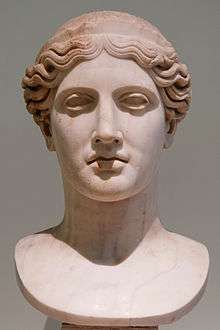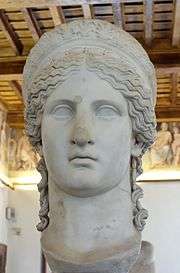Hera Farnese
Its main example is a 63 cm high Roman marble copy of the 1st century AD of a Greek original of the second half of the 5th century BC, now in the Naples National Archaeological Museum. It was part of a colossal acrolithic statue, and shows the goddess with a central parting and wearing a diadem. It was named Hera by the first archaeologists to see it, due to its severe style and unsmiling expression, and they also interpreted these features as making it a Roman copy of an original by Polycleitus.

The Hera Farnese is a type of sculpture of Hera.
As part of the Farnese collection it was brought to Naples in 1844 by German archaeologist Heinrich von Brunn[1]

See also giant statue Hera Ludovisi (portrait of Antonia Minor) in Palazzo Altemps, Rome.
Notes
- Alfred Emerson, 'Heinrich von Brunn', The American Journal of Archaeology and of the History of the Fine Arts, Vol. 9, No. 3 (Jul., 1894), pp. 370